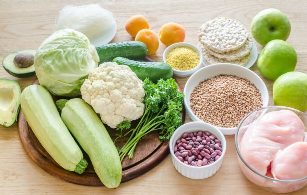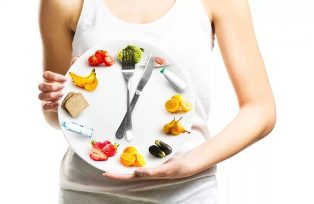Which woman does not dream of having a beautiful waist and slender legs? How much energy, time and energy it takes to cherish the parameters. Nowadays, the Japanese diet is very popular-ideal for fast weight loss. If you need to lose weight shortly before an important event, it is perfect. Japanese diet has many positive reviews, and it has long been established as one of the most effective diets. On average, thanks to Japanese eating habits, you can lose 8-10 kg in 14 days. The result is very good, but you must show a certain endurance. They said that to gain the demeanor of a geisha, it takes a little samurai's patience. Therefore, turn your will into a fist-it is difficult for us to walk in fourteen days, this will definitely bring good results
Japanese diet-basic principles
Let's take a closer look at Japanese eating habits. what does she like? It is difficult to say exactly who is the author of this diet. Just know that it was developed in a Japanese clinic. But don't be fooled-there are no Japanese in the diet. All ingredients are as close to Europe as possible, you can buy them in any store, and they are very expensive on a budget.

The main principle of the diet is based on almost no carbohydrates and fats, banning salt, sugar, spices and small amounts of food.
Using the right method, you will not only see good results, but you will be able to maintain your weight in the next few years. Just remember that after a diet, you should never go all out to indulge in binge eating-you will not only gain weight again, but also seriously damage your health. Physical exercise has not been cancelled, and without them, any diet will be invalid.
Important note: This diet can only be repeated after two to three years, and it is absolutely impossible to continue for more than fourteen days-the Japanese diet is one of the most strict and non-compliance with regulations can seriously affect your health.
Japanese diet-contraindications
Japanese diet has strict contraindications for 14 days:
- Gastrointestinal disease, any form of peptic ulcer disease, liver disease;
- Endocrine system diseases, hormonal imbalance;
- Cardiovascular diseases;
- Kidney disease;
- pregnancy;
- Lactation period;
- Puberty;
- The body and mind are stressed.
If you feel pain, weakness, headache, deterioration of health, you must immediately interrupt your diet and consult a doctor!
If you are not confident about your abilities, please consult your doctor before starting a diet. You need to lose weight correctly and safely!
14 Days of Japanese Diet-Basic Rules
The basic and most important rule of Japanese diet is to follow the plan. You cannot change your eating habits and change products independently. Japanese eating habits are also very strict, because not only a complete list of acceptable foods is listed, but also the number of meals are listed, and each food has a clear menu. If you decide to use this diet, you need to strictly follow the rules. The final result depends not only on this, but also on your health. Therefore, before you begin, carefully consider whether you and your body can cope with this situation.
Let us get familiar with the basic rules of Japanese diet:
- Entry and exit of Japanese food should be prepared in advance. A few days before starting a diet, give up sweet, flour, and high-calorie foods. Gradually adjust your serving size. After the diet is over, do not eat in a hurry. Gradually introduce high-calorie, salty, sweet or spicy foods to your menu. So that the body will not suffer unnecessary vibrations.
- During the Japanese diet, it is very important to observe strict drinking habits-drink at least 1. 5 liters of water a day. This will ensure the elimination of processed animal protein, excessive salt products. Since salt is prohibited in this diet, the loss of water will be greater than usual-this must be compensated for. Drink water on an empty stomach 30-40 minutes before the first meal, and drink 1-2 glasses of water. This can be done even after a diet-this is how you get up in the morning, activate your digestive system, and help cleanse and remove toxins.
- Completely eliminate salt, sugar and other spices. If you absolutely must not add salt, you can use the least amount of this product. But it is best to give it up completely, after the diet is over, you will know how much salt you have used before. But for sugar and spices, the ban is strict-a little lemon juice can be used instead of spices.
- The proportion of food should be as small as possible and not overeating (you are unlikely to succeed, but you can still). During dieting, the stomach wall should contract to ensure that hunger and fullness are reduced later.
- Although there is very little food, the diet is very balanced. You will get the necessary protein from eggs, lean meat and fish. The human body takes in carbohydrates and fiber from meat, fresh vegetables and fruits, which are necessary for normal digestion. There is almost no fat, and the only source is high-quality vegetable oil. It is best to use extra virgin olive oil, but you can choose linseed oil, pumpkin seed oil, etc.
- The last meal should be at least three hours before bedtime. This rule is universal to everyone, not only in diet. Sleeping with a full stomach not only increases weight, but also leads to the development of gastrointestinal diseases.
Japanese diet menu-prohibited and permitted foods
Let's take a closer look at the acceptable foods in the Japanese diet and which foods will make you forget in two weeks. First, let us figure out what food we will eat in the next two weeks. Although you will have to forget all the delicious, more or less high-calorie foods, there is good news-a Japanese diet can not only help you lose weight, but also save money. All necessary products are very cheap and affordable. Therefore, in the end, you can not only put on the clothes you like, and have not worn them for years, you can also save money on new shoes.
See the Japanese product list diet:
- Premium instant coffee or green tea leaves (depending on your preference);
- Eggs (quail can be used instead-weight ratio is 1: 4);
- Cold pressed olive oil or any other high-quality vegetable oil;
- Cabbage or lettuce (any variety except kohlrabi);
- Carrots; zucchini or eggplant;
- chicken fillet;
- Sea fish fillet (lean meat-cod, cod, pollock, etc. ) lean beef fillet;
- Natural low-fat kefir or yogurt;
- Tomato juice;
- Lemon;
- Low-fat cheese;
- Rye rusk;
- Fresh fruits with low sugar;
- Pure non-carbonated water.

Now, let’s take a look at the foods that must be completely excluded from the diet:
- Fatty meat, fish;
- Any dairy products, cheese, sweet yogurt;
- Bread, pastries, sweets; pasta, cereals;
- Sweet fruits (bananas, grapes, figs, persimmons, etc. ) other vegetables other than those listed on the acceptable food list;
- Sugar, salt, spices, seasonings, sauces;
- Semi-finished products, convenience food;
- Smoked, fried food;
- Carbonated sweet alcoholic beverages.
The list is huge, and people who like delicious food will immediately lead to frustration. But you should not feel sad-a temporary lack of nutrition will only benefit you. Maintain patience and perseverance and confidently start the two-week road to harmony.
14-day menu of Japanese food
There are five, seven and 13-day shortened versions of the Japanese diet, but the classic 14-day version is considered the most effective. Consider the entire menu of Japanese food for two weeks in the table.
| days | Breakfast | Lunch | Dinner | 1 | A cup of coffee without sugar, milk or green tea, and a slice of toasted rye bread. | Stewed cabbage with a little oil, two hard-boiled or hard-boiled eggs, and a glass of tomato juice. The cabbage can be replaced with fresh salad, sprinkled with lemon juice and olive oil. | 200 grams of boiled or steamed fish. |
| 2 | A cup of coffee without sugar, milk or green tea, and a slice of dry rye bread. | 200 grams of steamed fish, stewed with a spoonful of olive oil or chopped cabbage. | 100 grams boiled beef, a cup of low-fat kefir. | ||||
| 3 | An empty cup of coffee or tea, rye toast. | Zucchini or eggplant is fried in vegetable oil. | 200 grams of boiled beef, chopped raw cabbage with chopped olive oil and two boiled eggs. | ||||
| 4 | Grated fresh carrots and a spoonful of lemon juice. | 200 grams of steamed fish, a cup of tomato juice. | 200 grams of unsweetened fruit. | ||||
| 5 | Grated fresh carrots and a spoonful of lemon juice. | 200 grams of steamed fish, a cup of tomato juice. | 200 grams of unsweetened fruit. | ||||
| 6 | A cup of coffee without sugar or green tea. | 500 grams of chicken cooked or grilled in tin foil, chopped cabbage salad, chopped carrots and a spoonful of olive oil. | Chopped carrots, boil two eggs. | ||||
| 7 | A cup of sugar-free green tea or coffee. | 200 grams of boiled beef. | 200 grams of unsweetened fruit, or 200 grams of boiled fish, or fresh carrots and two eggs, or 200 grams of boiled beef, and a cup of low-fat kefir. | ||||
| 8 | A cup of sugar-free green tea or coffee. | Chicken cooked or grilled with 500 grams of foil, fresh cabbage salad and a spoonful of olive oil grated carrots. | Chopped carrots and a spoonful of olive oil, two boiled eggs. | ||||
| 9 | The carrots are sprinkled with lemon juice. | Cooked or steamed fish, a glass of tomato juice. | 200 grams of unsweetened fruit. | ||||
| 10 | A cup of coffee without sugar or green tea. | A piece of low-fat cheese, 50 grams, three medium-sized carrots, a spoonful of olive oil and a boiled egg. | 200 grams of unsweetened fruit. | ||||
| 11 | A cup of coffee without sugar or green tea, rye croutons. | Two zucchini or eggplants, fried or baked in the oven with a spoonful of vegetable oil. | Use aluminum foil or 200g boiled beef, 2 boiled eggs, a spoonful of olive oil and chopped cabbage grilled. | ||||
| 12 | A cup of coffee without sugar or green tea. | 200 grams of steamed or boiled fish, chopped cabbage and a spoonful of olive oil. | Bake 200g beef with foil or boiled beef, a cup of low-fat kefir or yogurt. | ||||
| 13 | A cup of coffee without sugar or green tea. | Chopped cabbage with a spoonful of olive oil, two boiled eggs and a glass of tomato juice. | 200 grams of boiled or steamed fish. | ||||
| 14 | A cup of coffee without sugar or green tea. | 200 grams of cooked or steamed fish, chopped cabbage and a spoonful of olive oil. | Use aluminum foil or boiled beef roast 200 grams, a cup of low-fat kefir or yogurt |
Before starting a diet, you can print this sheet and hang it on the refrigerator-it is very convenient to visually view the daily menu.
It is recommended that you attach a photo nearby to reduce excess weight before wearing it-good motivation can help you avoid losing perseverance.
Japanese food menu for 14 days a day
1. The first day
- Breakfast: a cup of coffee without sugar, milk or green tea, and a slice of dry rye bread.
- Lunch: stewed cabbage with a little oil, two hard-boiled or hard-boiled eggs, a cup of tomato juice. The cabbage can be replaced with fresh salad, sprinkled with lemon juice and olive oil.
- Dinner: 200 grams of boiled or steamed fish.
2. The next day
- Breakfast: a cup of sugar-free coffee or tea, a slice of rye bread or croutons.
- Lunch: 200 grams of steamed fish, stewed with a spoonful of olive oil or chopped cabbage.
- Dinner: 100 grams of boiled beef, a cup of low-fat kefir.
3. The third day
- Breakfast: an empty cup of coffee or tea, rye croutons.
- Lunch: Zucchini or eggplant is fried in vegetable oil.
- Dinner: 200 grams of boiled beef, chopped cabbage and a spoonful of olive oil, two boiled eggs.
4. The fourth day
- Breakfast: chopped fresh carrots and a spoonful of lemon juice.
- Lunch: 200 grams of steamed fish, a glass of tomato juice.
- Dinner: 200 grams of unsweetened fruit.
5. The fifth day
- Breakfast: chopped fresh carrots and a spoonful of lemon juice.
- Lunch: 200 grams of steamed fish, a glass of tomato juice.
- Dinner: 200 grams of unsweetened fruit.
6. The sixth day
- Breakfast: A cup of coffee without sugar or green tea.
- Lunch: 500 grams of cooked or grilled chicken with foil, chopped cabbage salad, chopped carrots and a spoonful of olive oil.
- Dinner: Ground carrots, two boiled eggs.
7. The seventh day
- Breakfast: A cup of sugar-free green tea or coffee.
- Lunch: 200 grams of boiled beef.
- Dinner: 200 grams of unsweetened fruit, or 200 grams of boiled fish, or fresh carrots and two eggs, or 200 grams of boiled beef and a cup of low-fat kefir.
8. Day 8
- Breakfast: A cup of sugar-free green tea or coffee.
- Lunch: Chicken cooked or grilled with 500 grams of foil, fresh cabbage salad and a spoonful of olive oil grated carrots.
- Dinner: chopped carrots, add a spoonful of olive oil, and two boiled eggs.
9. The ninth day
- Breakfast: Sprinkle the minced carrots with lemon juice.
- Lunch: boiled or steamed fish, a glass of tomato juice.
- Dinner: 200 grams of unsweetened fruit.
10. The tenth day
- Breakfast: A cup of coffee without sugar or green tea.
- Lunch: a piece of low-fat cheese, 50 grams, three medium-grated carrots, a spoonful of olive oil and a boiled egg.
- Dinner: 200 grams of unsweetened fruit.
11. The eleventh day
- Breakfast: a cup of coffee without sugar or green tea, rye croutons.
- Lunch: Two zucchini or eggplants fried or baked in the oven with a spoonful of vegetable oil.
- Dinner: grilled with 200 grams of aluminum foil or boiled beef, 2 boiled eggs, chopped cabbage and a spoonful of olive oil.
12. The twelfth day
- Breakfast: A cup of coffee without sugar or green tea.
- Lunch: 200 grams of steamed or boiled fish, chopped cabbage and a spoonful of olive oil.
13. The thirteenth day
- Breakfast: A cup of coffee without sugar or green tea.
- Lunch: chopped cabbage with a spoonful of olive oil, two boiled eggs, a cup of tomato juice.
- Dinner: 200 grams of boiled or steamed fish.
14. The fourteenth day
- Breakfast: A cup of coffee without sugar or green tea.
- Lunch: 200 grams of boiled or steamed fish, chopped cabbage and a spoonful of olive oil.

The right way to get out of Japanese diet
After two weeks of difficult psychological preparation and a difficult and almost hungry regime, the next phase is equally important-withdrawal from the Japanese diet. It has been said that exports should be gradual, and it is absolutely impossible to introduce all types of products into the diet and increase their proportions immediately. This will not only lead to weight gain, but also serious health problems. The first adequate lunch can cause nausea, vomiting and severe pain. After a two-week diet marathon, your stomach simply cannot withstand this pressure.
In order not to shock the body, after finishing eating, please follow the following rules:
- Resuming a normal diet immediately after the diet will not work. This will have to be done gradually-within one to two weeks. Introduce commonly used products step by step, and slightly expand their use ratio.
- Started to expand the diet by introducing heavy carbohydrates-grains, fruits and vegetables. Add one or two products to the menu every day. Gradually increase the calorie content in food.
- Early salt intake should also be minimized-this is necessary so as not to damage the kidneys. After a diet, you are unlikely to need salt. The most common thing is that in the diet we are used to, there is much more salt than normal people. The Japanese diet can be a great excuse to switch to a healthy, low-salt diet.
- After you quit, try not to restore high-calorie junk food. Make a balanced diet a good habit. This will not only keep you in shape but also keep healthy.
- Don't forget to exercise. During and after eating. With a sedentary lifestyle, almost any diet will be ineffective. In order to stay healthy and beautiful, you need to make sports friends. Don't treat training as a punishment, because participating in sports can be fun.
One more thing, in the first few days after a diet, you can suddenly gain a few kilograms. Don't panic-it's just liquid, and since you start to consume salt, the removal rate will be slower.
Otherwise, if you follow all the rules, there should be no annoying surprises.
































































